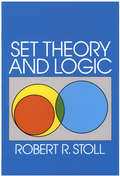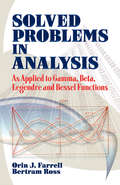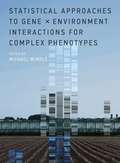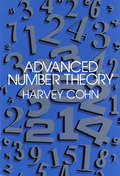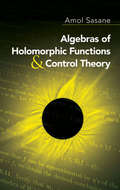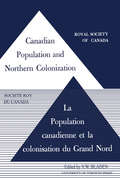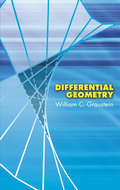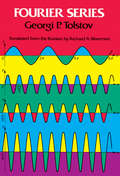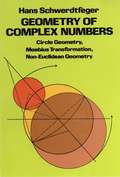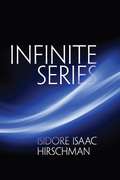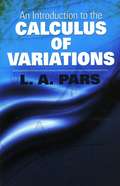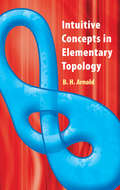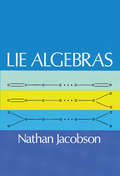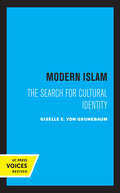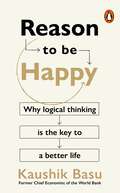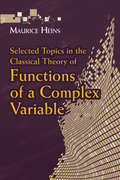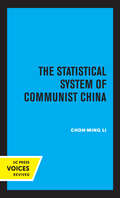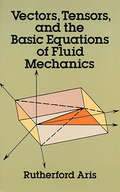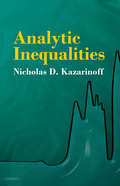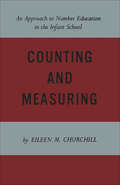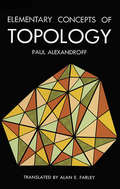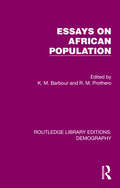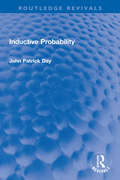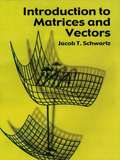- Table View
- List View
Set Theory and Logic
by Robert R. StollSet Theory and Logic is the result of a course of lectures for advanced undergraduates, developed at Oberlin College for the purpose of introducing students to the conceptual foundations of mathematics. Mathematics, specifically the real number system, is approached as a unity whose operations can be logically ordered through axioms. One of the most complex and essential of modern mathematical innovations, the theory of sets (crucial to quantum mechanics and other sciences), is introduced in a most careful concept manner, aiming for the maximum in clarity and stimulation for further study in set logic. Contents include: Sets and Relations -- Cantor's concept of a set, etc.Natural Number Sequence -- Zorn's Lemma, etc.Extension of Natural Numbers to Real NumbersLogic -- the Statement and Predicate Calculus, etc.Informal Axiomatic MathematicsBoolean AlgebraInformal Axiomatic Set TheorySeveral Algebraic Theories -- Rings, Integral Domains, Fields, etc.First-Order Theories -- Metamathematics, etc.Symbolic logic does not figure significantly until the final chapter. The main theme of the book is mathematics as a system seen through the elaboration of real numbers; set theory and logic are seen s efficient tools in constructing axioms necessary to the system. Mathematics students at the undergraduate level, and those who seek a rigorous but not unnecessarily technical introduction to mathematical concepts, will welcome the return to print of this most lucid work. "Professor Stoll . . . has given us one of the best introductory texts we have seen." -- Cosmos. "In the reviewer's opinion, this is an excellent book, and in addition to its use as a textbook (it contains a wealth of exercises and examples) can be recommended to all who wish an introduction to mathematical logic less technical than standard treatises (to which it can also serve as preliminary reading)." -- Mathematical Reviews.
Solved Problems in Analysis: As Applied to Gamma, Beta, Legendre and Bessel Functions (Dover Books on Mathematics)
by Orin J. Farrell Bertram RossNearly 200 problems, each with a detailed, worked-out solution, deal with the properties and applications of the gamma and beta functions, Legendre polynomials, and Bessel functions. The first two chapters examine gamma and beta functions, including applications to certain geometrical and physical problems such as heat-flow in a straight wire. The following two chapters treat Legendre polynomials, addressing applications to specific series expansions, steady-state heat-flow temperature distribution, gravitational potential of a circular lamina, and application of Gauss's mechanical quadrature formula with pertinent table. The final chapters explore Bessel functions, discussing differentiation formulas, generating functions, relations to Legendre polynomials, and other applications.This volume constitutes a useful tool for professional engineers and experimental physicists. Students of mathematics, physics, and engineering will particularly benefit from the book's expanded solutions.
Statistical Approaches to Gene x Environment Interactions for Complex Phenotypes
by Michael WindleFindings from the Human Genome Project and from Genome-Wide Association (GWA) studies indicate that many diseases and traits manifest a more complex genomic pattern than previously assumed. These findings, and advances in high-throughput sequencing, suggest that there are many sources of influence -- genetic, epigenetic, and environmental. This volume investigates the role of the interactions of genes and environment (G × E) in diseases and traits (referred to by the contributors as complex phenotypes) including depression, diabetes, obesity, and substance use. The contributors first present different statistical approaches or strategies to address G × E and G × G interactions with high-throughput sequenced data, including two-stage procedures to identify G × E and G × G interactions, marker-set approaches to assessing interactions at the gene level, and the use of a partial-least square (PLS) approach. The contributors then turn to specific complex phenotypes, research designs, or combined methods that may advance the study of G × E interactions, considering such topics as randomized clinical trials in obesity research, longitudinal research designs and statistical models, and the development of polygenic scores to investigate G × E interactions.ContributorsFatima Umber Ahmed, Yin-Hsiu Chen, James Y. Dai, Caroline Y. Doyle, Zihuai He, Li Hsu, Shuo Jiao, Erin Loraine Kinnally, Yi-An Ko, Charles Kooperberg, Seunggeun Lee, Arnab Maity, Jeanne M. McCaffery, Bhramar Mukherjee, Sung Kyun Park, Duncan C. Thomas, Alexandre Todorov, Jung-Ying Tzeng, Tao Wang, Michael Windle, Min Zhang
Advanced Number Theory
by Harvey Cohn"A very stimulating book ... in a class by itself." -- American MathematicalMonthlyAdvanced students, mathematicians and number theorists will welcome this stimulating treatment of advanced number theory, which approaches the complex topic of algebraic number theory from a historical standpoint, taking pains to show the reader how concepts, definitions and theories have evolved during the last two centuries. Moreover, the book abounds with numerical examples and more concrete, specific theorems than are found in most contemporary treatments of the subject.The book is divided into three parts. Part I is concerned with background material -- a synopsis of elementary number theory (including quadratic congruences and the Jacobi symbol), characters of residue class groups via the structure theorem for finite abelian groups, first notions of integral domains, modules and lattices, and such basis theorems as Kronecker's Basis Theorem for Abelian Groups.Part II discusses ideal theory in quadratic fields, with chapters on unique factorization and units, unique factorization into ideals, norms and ideal classes (in particular, Minkowski's theorem), and class structure in quadratic fields. Applications of this material are made in Part III to class number formulas and primes in arithmetic progression, quadratic reciprocity in the rational domain and the relationship between quadratic forms and ideals, including the theory of composition, orders and genera. In a final concluding survey of more recent developments, Dr. Cohn takes up Cyclotomic Fields and Gaussian Sums, Class Fields and Global and Local Viewpoints.In addition to numerous helpful diagrams and tables throughout the text, appendices, and an annotated bibliography, Advanced Number Theory also includes over 200 problems specially designed to stimulate the spirit of experimentation which has traditionally ruled number theory.
Algebras of Holomorphic Functions and Control Theory
by Amol SasaneThis accessible, undergraduate-level text illustrates the role of algebras of holomorphic functions in the solution of an important engineering problem: the stabilization of a linear control system. Its concise and self-contained treatment avoids the use of higher mathematics and forms a bridge to more advanced treatments. The treatment consists of two components: the algebraic framework, which serves as the abstract language for posing and solving the problem of stabilization; and the analysis component, which examines properties of specific rings of holomorphic functions. Elementary, self-contained, and constructive proofs elucidate the explorations of rings of holomorphic functions relevant in control theory. Introductory chapters on control theory and stable transfer functions are followed by surveys of unstable plants and the stabilization problem and its solution. The text concludes with suggestions for further reading and a bibliography.
Canadian Population and Northern Colonization/La Population canadienne et al colonisation du Grand Nord: Symposium presented to the Royal Society of Canada/Colloque presente a la Societe Royale du Canada (Royal Society of Canada Studia Varia Series #no. 8)
by V. W. BladenIn their annual sessions the various Sections of the Royal Society are accustomed to take up for general discussion a topic of current interest and this gives Fellows and special guests from the natural sciences, the social sciences, and the humanities an opportunity for useful communication across the disciplines on an important subject.<P><P>In 1961 the topic was an especially vital issue, the population explosion, and this volume, based on the papers given at the meeting, has much valuable information and many pertinent and provocative comments on this phenomenon particularly as it affects Canada.<P>T.W.M. Cameron leads off with a general background on the causes and consequences of the population increase around the world. Then come a group of papers presenting various aspects of the population in Canada's settled areas. Pierre Dagenais studies the growth in that population in recent years; Guy Rocher presents developments in our labour force in the 1900's with particular reference to the older age group, to women, and to the unemployed; Jacques Henripin describes ethnic and linguistic patterns over the country; Nathan Keyfitz outlines new patterns in the birth rate and their significance. A.R.M. Lower concludes this portion of the book with a lively historical study of the effects of natural increase and waves of immigration in the French and English periods, leading on to our present "bold experiment" in Canada which assumes the "risks of a non-homogeneous, non-integral society with every value fighting it out for survival."<P>The second part of the book turns to those largely unsettled areas stretching away in Canada's north and considers the potentialities of these areas as a more permanent habitat for man. With an introduction by René Pomerleau, various problems of settlement are brought forward. W. Keith Buck and D.J.F. Henderson discuss economic aspects of mineral development in the north; E.W. Humphrys, the possible use of atomic energy as a way of coping with fuel and supply; M.J. Dunbar, the prospects of support for a new population in the use natural resources contributed by the land and the sea; G. Malcolm Brown, problems of man's acclimatization to life in a colder climate; Trevor Lloyd, the kind of settlement in the Far North which is desirable and possible given its special conditions of subsistence and transportation and economic activity. All these authors stress that any planning for a northern future "must be based on a broad, systematic and thorough scientific appraisal."<P>This is an important and absorbing book and it will give both specialist and general reader much to think about.
Differential Geometry
by William C. GrausteinThis first course in differential geometry presents the fundamentals of the metric differential geometry of curves and surfaces in a Euclidean space of three dimensions. Written by an outstanding teacher and mathematician, it explains the material in the most effective way, using vector notation and technique. It also provides an introduction to the study of Riemannian geometry.Suitable for advanced undergraduates and graduate students, the text presupposes a knowledge of calculus. The first nine chapters focus on the theory, treating the basic properties of curves and surfaces, the mapping of surfaces, and the absolute geometry of a surface. The final chapter considers the applications of the theory to certain important classes of surfaces: surfaces of revolution, ruled surfaces, translation surfaces, and minimal surfaces. Nearly 200 problems appear throughout the text, offering ample reinforcement of every subject.
Fourier Series
by Georgi P. TolstovRichard A. Silverman's series of translations of outstanding Russian textbooks and monographs is well-known to people in the fields of mathematics, physics, and engineering. The present book is another excellent text from this series, a valuable addition to the English-language literature on Fourier series.This edition is organized into nine well-defined chapters: Trigonometric Fourier Series, Orthogonal Systems, Convergence of Trigonometric Fourier Series, Trigonometric Series with Decreasing Coefficients, Operations on Fourier Series, Summation of Trigonometric Fourier Series, Double Fourier Series and the Fourier Integral, Bessel Functions and Fourier-Bessel Series, and the Eigenfunction Method and its Applications to Mathematical Physics. Every chapter moves clearly from topic to topic and theorem to theorem, with many theorem proofs given. A total of 107 problems will be found at the ends of the chapters, including many specially added to this English-language edition, and answers are given at the end of the text. Richard Silverman's excellent translation makes this book readily accessible to mathematicians and math students, as well as workers and students in the fields of physics and engineering. He has also added a bibliography, containing suggestions for collateral and supplementary reading. 1962 edition.
Geometry of Complex Numbers
by Hans SchwerdtfegerSince its initial publication in 1962, Professor Schwerdtfeger's illuminating book has been widely praised for generating a deeper understanding of the geometrical theory of analytic functions as well as of the connections between different branches of geometry. Its focus lies in the intersection of geometry, analysis, and algebra, with the exposition generally taking place on a moderately advanced level. Much emphasis, however, has been given to the careful exposition of details and to the development of an adequate algebraic technique.In three broad chapters, the author clearly and elegantly approaches his subject. The first chapter, Analytic Geometry of Circles, treats such topics as representation of circles by Hermitian matrices, inversion, stereographic projection, and the cross ratio. The second chapter considers in depth the Moebius transformation: its elementary properties, real one-dimensional projectivities, similarity and classification of various kinds, anti-homographies, iteration, and geometrical characterization. The final chapter, Two-Dimensional Non-Euclidean Geometries, discusses subgroups of Moebius transformations, the geometry of a transformation group, hyperbolic geometry, and spherical and elliptic geometry. For this Dover edition, Professor Schwerdtfeger has added four new appendices and a supplementary bibliography.Advanced undergraduates who possess a working knowledge of the algebra of complex numbers and of the elements of analytical geometry and linear algebra will greatly profit from reading this book. It will also prove a stimulating and thought-provoking book to mathematics professors and teachers.
Infinite Series
by Isidore Isaac HirschmanThis text for advanced undergraduate and graduate students presents a rigorous approach that also emphasizes applications. Encompassing more than the usual amount of material on the problems of computation with series, the treatment offers many applications, including those related to the theory of special functions. Numerous problems appear throughout the book.The first chapter introduces the elementary theory of infinite series, followed by a relatively complete exposition of the basic properties of Taylor series and Fourier series. Additional subjects include series of functions and the applications of uniform convergence; double series, changes in the order of summation, and summability; power series and real analytic functions; and additional topics in Fourier series. The text concludes with an appendix containing material on set and sequence operations and continuous functions.
An Introduction to the Calculus of Variations
by L. A. ParsThis clear, rigorous introduction to the calculus of variations covers applications to geometry, dynamics, and physics. Focusing upon problems with one independent variable, the text connects the abstract theory to its use in concrete problems. It offers a working knowledge of relevant techniques, plus an impetus for further study.Starting with an overview of fundamental problems and theories, the text advances to illustrative examples and examinations of variable end-points and the fundamental sufficiency theorem. Subsequent chapters explore the isoperimetrical problem, curves in space, the problem of Lagrange, and the parametric problem. The final chapter is devoted to multiple integrals, with a particular focus on Dirichlet's principle. Suitable for advanced undergraduate and graduate students, this text requires a background in mathematical analysis.
Intuitive Concepts in Elementary Topology
by B. H. ArnoldClassroom-tested and much-cited, this concise text offers a valuable and instructive introduction for undergraduates to the basic concepts of topology. It takes an intuitive rather than an axiomatic viewpoint, and can serve as a supplement as well as a primary text.A few selected topics allow students to acquire a feeling for the types of results and the methods of proof in mathematics, including mathematical induction. Subsequent problems deal with networks and maps, provide practice in recognizing topological equivalence of figures, examine a proof of the Jordan curve theorem for the special case of a polygon, and introduce set theory. The concluding chapters examine transformations, connectedness, compactness, and completeness. The text is well illustrated with figures and diagrams.
Lie Algebras (Dover Books on Mathematics)
by Nathan JacobsonLie group theory, developed by M. Sophus Lie in the 19th century, ranks among the more important developments in modern mathematics. Lie algebras comprise a significant part of Lie group theory and are being actively studied today. This book, by Professor Nathan Jacobson of Yale, is the definitive treatment of the subject and can be used as a textbook for graduate courses.Chapter I introduces basic concepts that are necessary for an understanding of structure theory, while the following three chapters present the theory itself: solvable and nilpotent Lie algebras, Carlan's criterion and its consequences, and split semi-simple Lie algebras. Chapter 5, on universal enveloping algebras, provides the abstract concepts underlying representation theory. Then the basic results on representation theory are given in three succeeding chapters: the theorem of Ado-Iwasawa, classification of irreducible modules, and characters of the irreducible modules. In Chapter 9 the automorphisms of semi-simple Lie algebras over an algebraically closed field of characteristic zero are determined. These results are applied in Chapter 10 to the problems of sorting out the simple Lie algebras over an arbitrary field. The reader, to fully benefit from this tenth chapter, should have some knowledge about the notions of Galois theory and some of the results of the Wedderburn structure theory of associative algebras.Nathan Jacobson, presently Henry Ford II Professor of Mathematics at Yale University, is a well-known authority in the field of abstract algebra. His book, Lie Algebras, is a classic handbook both for researchers and students. Though it presupposes a knowledge of linear algebra, it is not overly theoretical and can be readily used for self-study.
Modern Islam: The Search for Cultural Identity
by G. E. Von GrunebaumThis title is part of UC Press's Voices Revived program, which commemorates University of California Press’s mission to seek out and cultivate the brightest minds and give them voice, reach, and impact. Drawing on a backlist dating to 1893, Voices Revived makes high-quality, peer-reviewed scholarship accessible once again using print-on-demand technology. This title was originally published in 1962.
Reason to Be Happy: Why logical thinking is the key to a better life
by Kaushik Basu'Reason to Be Happy is a wise and witty book that shows how thinking clearly can help us find happiness in our daily lives, get more of what we want, and even make the world a better place' Hannah FryWhy do our friends have more friends than we do? How do you book the best available seats on a plane? And if jogging for ten minutes adds eight minutes to our life expectancy, should we still go jogging?The ability to reason is one of our most undervalued skills. In everyday life, the key is to put yourself in the shoes of a clever competitor and think about how they might respond. Whether you are dealing with events on the scale of the Cuban missile crisis or letting go of anger, leading economist Professor Kaushik Basu shows how game theory - the logic of social situations - can help us achieve better outcomes and lasting happiness.Full of fascinating thought experiments and puzzles, Reason to Be Happy is a paean to the power of rationality. If you want to have a good life and even make the world a better place, you can start by thinking clearly.
Selected Topics in the Classical Theory of Functions of a Complex Variable (Dover Books on Mathematics)
by Maurice HeinsElegant and concise, this text is geared toward advanced undergraduate students acquainted with the theory of functions of a complex variable. The treatment presents such students with a number of important topics from the theory of analytic functions that may be addressed without erecting an elaborate superstructure. These include some of the theory's most celebrated results, which seldom find their way into a first course. After a series of preliminaries, the text discusses properties of meromorphic functions, the Picard theorem, and harmonic and subharmonic functions. Subsequent topics include applications and the boundary behavior of the Riemann mapping function for simply connected Jordan regions. The book concludes with a helpful Appendix containing information on Lebesgue's theorem and other topics.
The Statistical System of Communist China
by Choh-Ming LiOne of the most baffling problems in contemporary Chinese economic studies concerns the validity of official statistics. In the continuing discussion of claims and counter-claims, appeals to common sense are unconvincing. Because of the pressing need for substantial evidence on which to base a judgment, the present inquiry is an important contribution to the literature on Communist China. The book provides a quizzical but objective look at the statistical system of the country, and attempts to appraise the quality of official statistics by analyzing the development and inner working of the sytem. Its approach is broadly historical, beginning with the pre-Communist period (before 1949) and dividing the next dozen years into phases: the foundation of the state statistical system (1952 - 57), the period of decentralization (1958 - 59), and subsequent efforts at reorganization. Li's study of the development of a national statistical system in China is particularly instructive in delineating both the obstacles to such development that may be expected in a densely populated, largely agricultural country and the measure that have been adopted to overcome them. Therefore his hard-headed conclusions concerning the Chinese experience should be of lively intrest in those underdeveloped countries that are now planning or executing development programs. This title is part of UC Press's Voices Revived program, which commemorates University of California Press's mission to seek out and cultivate the brightest minds and give them voice, reach, and impact. Drawing on a backlist dating to 1893, Voices Revived makes high-quality, peer-reviewed scholarship accessible once again using print-on-demand technology. This title was originally published in 1962.
Statistical Treatment of Experimental Data
by Hugh D. YoungDealing with statistical treatment of experimental data, this text covers topics such as errors, probability, the binomial distribution, the Poisson distribution, the Gauss distribution, method of least squares and standard deviation of the mean.
Vectors, Tensors and the Basic Equations of Fluid Mechanics
by Rutherford ArisThis introductory text is geared toward engineers, physicists, and applied mathematicians at the advanced undergraduate and graduate levels. It applies the mathematics of Cartesian and general tensors to physical field theories and demonstrates them chiefly in terms of the theory of fluid mechanics. Numerous exercises appear throughout the text. 1962 edition.
Analytic Inequalities
by Nicholas D. KazarinoffMathematical analysis is largely a systematic study and exploration of inequalities -- but for students the study of inequalities often remains a foreign country, difficult of access. This book is a passport to that country, offering a background on inequalities that will prepare undergraduates (and even high school students) to cope with the concepts of continuity, derivative, and integral.Beginning with explanations of the algebra of inequalities and conditional inequalities, the text introduces a pair of ancient theorems and their applications. Explorations of inequalities and calculus cover the number e, examples from the calculus, and approximations by polynomials. The final sections present modern theorems, including Bernstein's proof of the Weierstrass approximation theorem and the Cauchy, Bunyakovskii, Hölder, and Minkowski inequalities. Numerous figures, problems, and examples appear throughout the book, offering students an excellent foundation for further studies of calculus.
Counting and Measuring: An Approach to Number Education in the Infant School
by Eileen M. ChurchillThe teaching of numbers in the primary grades is seen in this book as the foundation of the beginnings of mathematical understanding. Mathematics is taken to be a language, and the aim of its teaching is to make the pupil, so to speak, bilingual, or so to increase his understanding that he is able to translate a concrete numerical problem into the symbolic language of calculation. For a child taught along these lines, how much easier, for example, would be the transition from arithmetic to algebra!<P><P>Miss Churchill is fully conversant with the works of Piaget, Cuisenaire, Cassirer and other leading thinkers in educational philosophy, psychology, and linguistics. She has synthesized their concepts with her own experience and research at Leeds University, and, though written within the contexts of British education, her book should also have a marked influence on the teaching of young children in North America.
Elementary Concepts of Topology
by Paul AlexandroffAlexandroff's beautiful and elegant introduction to topology was originally published in 1932 as an extension of certain aspects of Hilbert's Anschauliche Geometrie. The text has long been recognized as one of the finest presentations of the fundamental concepts, vital for mathematicians who haven't time for extensive study and for beginning investigators.The book is not a substitute for a systematic text, but an unusually useful intuitive approach to the basic concepts. Its aim is to present these concepts in a clear, elementary fashion without sacrificing their profundity or exactness and to give some indication of how they are useful in increasingly more areas of mathematics. The author proceeds from the basics of set-theoretic topology, through those topological theorems and questions which are based upon the concept of the algebraic complex, to the concept of Betti groups which binds together central topological theories in a whole and upon which applications of topology largely rest.Wholly consistent with current investigations, in which a larger and larger part of topology is governed by the concept of homology, the book deals primarily with the concepts of complex, cycle, and homology. It points the way toward a systematic and entirely geometrically oriented theory of the most general structures of space.First English translation, prepared for Dover by Alan E. Farley. Preface by David Hilbert. Author's Foreword. Index. 25 figures.
Essays on African Population (Routledge Library Editions: Demography #16)
by K. M. BarbourOriginally published in 1961, this book comprises of 14 studies by scholars and officials with first-hand experience of Africa and deals with the nature and organization of population censuses and with the many uses to which their results may be put. Written at a time of political transition on the African continent it was vitally important that the collection and interpretation of statistics dealing with distribution, density, migration and occupation in Africa continued. This volume shows how demographers, sociologists, anthropologists and geographers were using the research to be followed in the interpretation of the numerous censuses being conducted in the early 1960s.
Inductive Probability (Routledge Revivals)
by J. P. DayFirst published in 1961, Inductive Probability is a dialectical analysis of probability as it occurs in inductions. The book elucidates on the various forms of inductive, the criteria for their validity, and the consequent probabilities. This survey is complemented with a critical evaluation of various arguments concerning induction and a consideration of relation between inductive reasoning and logic. The book promises accessibility to even casual readers of philosophy, but it will hold particular interest for students of Philosophy, Mathematics and Logic.
Introduction to Matrices and Vectors (Dover Books on Mathematics)
by Jacob T. SchwartzRealizing that matrices can be a confusing topic for the beginner, the author of this undergraduate text has made things as clear as possible by focusing on problem solving, rather than elaborate proofs. He begins with the basics, offering students a solid foundation for the later chapters on using special matrices to solve problems.The first three chapters present the basics of matrices, including addition, multiplication, and division, and give solid practice in the areas of matrix manipulation where the laws of algebra do not apply. In later chapters the author introduces vectors and shows how to use vectors and matrices to solve systems of linear equations. He also covers special matrices -- including complex numbers, quaternion matrices, and matrices with complex entries -- and transpose matrices; the trace of a matrix; the cross product of matrices; eigenvalues and eigenvectors; and infinite series of matrices. Exercises at the end of each section give students further practice in problem solving. Prerequisites include a background in algebra, and in the later chapters, a knowledge of solid geometry. The book was designed as an introductory text for college freshmen and sophomores, but selected chapters can also be used to supplement advanced high school classes. Professionals who need a better understanding or review of the subject will also benefit from this concise guide.
